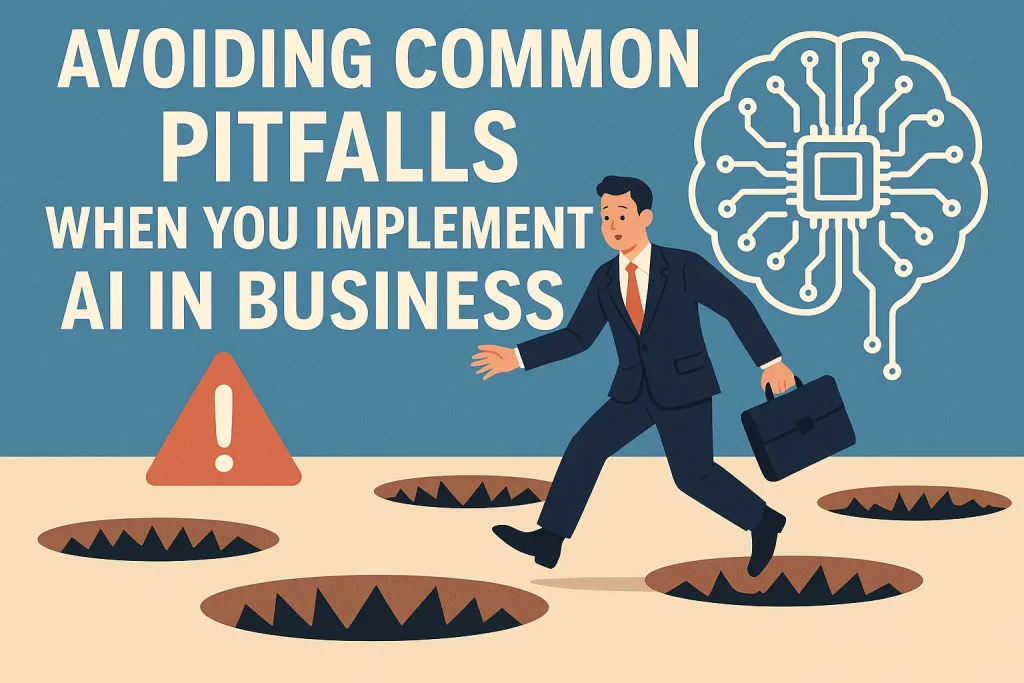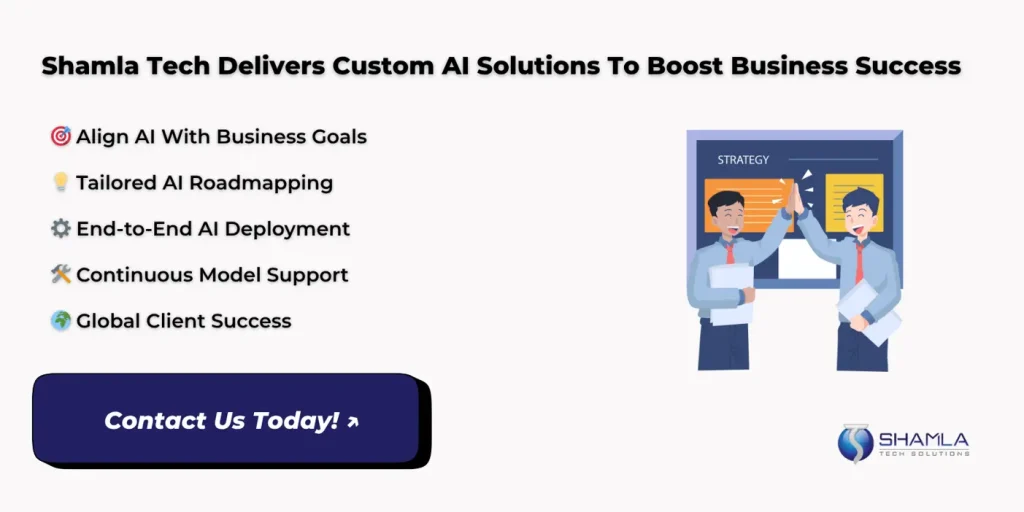Why Businesses Struggle Without a Structured Artificial Intelligence Strategy?
Many firms dive into AI with good energy but lack a clear plan. They pick tools without knowing if data fits, or if the cost makes sense. An artificial intelligence strategy must line up with business goals, legal rules, and budget limits. When no framework guides decisions, teams buy fancy software that does not match needs. Data teams spend weeks cleaning data but do not know the real question they need to answer. Meanwhile, other staff do not know how to use AI outputs. This mix of disjointed work leads to uneven models, slow rollouts, and extra cost.
Another big issue is ignoring security and rules. Without clear guardrails, data leaks or wrong use of personal data can lead to fines or loss of trust. When companies try to implement AI in business without real checks on privacy and security, they risk breaking rules or facing public backlash. They might build a model that seems smart but has bias, leading to wrong choices on hiring or lending.
Finally, lack of a solid plan means teams keep reworking ideas. Small AI wins in one department do not scale across other units. Without help from AI strategy consulting, companies face wasted budgets, frustrated staff, and slow time to value. A structured approach ensures focus on real issues, clear budgets, and rule checks.
Core Pillars of a Successful AI Implementation Strategy
A strong AI implementation strategy rests on three key areas:
1. Data Readiness
Data must be clear, clean, and well stored. Companies need to check if they have enough data and if it comes in a steady flow. They must set up rules on data handling, quality checks, and who can see or change data. Without this, AI models train on bad input and give wrong outputs. Setting up good data pipelines and labeling methods ensures each model learns from valid facts.
2. Problem-Solution Alignment
3. Roadmapping and Budgeting
Once data and goals are clear, build a step-by-step map:
- Phase 1: Proof of Concept (1 – 3 months) with minimal data and tools.
- Phase 2: Pilot (3 – 6 months) to refine models, add more data, and involve users.
- Phase 3: Rollout (6 – 12 months) where the model is live, monitored, and improved.
Assign clear budgets for each phase, including staffing, cloud compute, and security checks. Set measurable outcomes: accuracy targets (e.g., 95% model accuracy), ROI estimates (e.g., reduce processing time by 50%), and user adoption rates (e.g., 80% of staff use the AI tool within three months). Tracking these metrics ensures each phase ends with a clear pass/fail gate. This way, firms know if they should stop, adjust, or press on.
Spreading effort over multiple phases with set goals and budgets is the heart of a robust AI implementation strategy. It keeps the team focused, limits waste, and ensures they actually implement AI in business in steps that drive real gains.
The Role of AI Strategy Consulting in Reducing Risk
Bringing on AI strategy consulting cuts risks by providing outside know-how and tested frameworks. Consultants have seen common failures, overhyped pilots, hidden costs, data gaps – and can steer teams clear of those traps. When an internal team tries to build an artificial intelligence strategy, they may lack full view of potential pitfalls or hidden costs around data storage, compute scaling, or vendor lock-in. Expert consultants guide teams in picking the right models, choosing cloud vs. on-prem, and planning for growth without surprise bills.
Consultants also serve as a bridge between tech folks and leaders. They speak both “data science” and “business” clearly, translating technical limits into clear choices for execs. When you implement AI in business, getting buy-in from leaders is key. Consultants build clear roadmaps, outlining which tools fit the budget, where to start small, and when to expand. That straight talk helps execs fund projects with confidence, and it helps tech teams get clear priorities.
On the sales and revenue side, smart AI strategy consulting speeds up return on investment. Firms that work with consultants see faster pilot success, smoother scaling, and clearer cost controls. Consultants help set up monitoring systems so teams can watch model performance, flag drifts, and tweak data, all without needing a full data science lab. This means live systems can scale safely, giving solid value rather than hidden failures. With expert guidance, companies shorten the path from idea to money saved or earned.
Aligning Your Artificial Intelligence Strategy With Business Objectives
A strong artificial intelligence strategy always starts with business aims, not tech hype. To align AI to goals, follow this path:
- Identify Key Areas: Look at marketing, operations, finance, and service. Ask: where would faster insights or better automation give the biggest impact? For marketing, that might be using AI to target ads to high-value leads. For operations, AI could predict when machines might fail, cutting downtime. In finance, models could spot billing errors or fraud. In customer service, chatbots can handle routine questions, freeing reps to handle hard issues.
- Prioritize Initiatives: Rank each AI idea by expected value, ease of start, and risk. For example, a model to score leads could be quick to build from existing CRM data and deliver $50K in new sales per month. A deeper AI project, like building a real-time supply chain optimizer, might take longer, need more data, and carry more risk. Start with quick wins to build trust and budget for bigger projects later.
- Set Clear Metrics: For each AI use case, set baseline measures and targets. If the goal is to reduce call center time, measure average handle time now (say, 5 minutes per call) and aim to cut it to 3 minutes. If you want to cut inventory costs, track weekly stock variance and aim for a 20% drop. Embed checks at key dates (e.g., 30, 60, 90 days) to see if the initiative stays on track.
- Cross-Functional Teams: Form a small group with a project manager, a data engineer, a data scientist, a business lead, and an IT or security lead. This team meets weekly to track progress, fix data issues, update models, and make sure the push is always tied to business metrics. This stops the usual “project in a silo” problem where tech works in secret, then hands over code that no one uses.
When you implement AI in business, everything must tie back to clear business numbers: more sales, lower cost, faster delivery, or better customer scores. This ensures resources flow to the best projects and you avoid dead ends where fancy models never drive real change.
Avoiding Common Pitfalls When You Implement AI in Business
Even with a good plan, teams hit common snags. Being aware of these helps you stay on track:
- Tech-First Mindset: Relying on the newest algorithm or tool without linking to real problems leads to wasted time. Teams might chase high model scores on test data but fail to deploy anything useful. Always start with clear business questions: What does the sales team need? What reports can the finance team use? Asking these helps you pick simple, proven tools rather than chasing fancy trends.
- Skipping Stakeholder Buy-In: If key teams (IT, legal, operations, end users) are not on board, AI projects stall. IT might refuse access to servers, legal might block data sharing, or users might ignore the new dashboard. Right away, map all groups affected, hold kickoff sessions to show benefits, and build feedback loops. This way, no one feels blindsided, and you get fast support for data, servers, and user tests.
- Ignoring Change Management: AI can change how people work. Rolling out a new model or tool often disrupts daily routines. Without training or clear instructions, staff revert to old ways. Create simple user guides, hold training sessions, and assign “AI champions” in each department who can coach peers. Post-launch, set up support channels (chat group, helpdesk) so users can ask questions and get quick fixes. This keeps adoption high and prevents “AI tools forgotten in a folder.”
- Overlooking Maintenance: Models need ongoing care. Data drifts, code breaks, or new needs arise. If you build a model and forget it, performance drops. Plan for regular checks: monthly reviews of model accuracy, data quality scans, and cost reviews of cloud compute. Assign a team to own each model or tool, even after launch. This keeps performance high, lets you add new features, and ensures the AI implementation strategy evolves rather than ages out.
By watching for these pitfalls, tech-first pushes, missing buy-in, poor change work, and no maintenance, you make sure you really implement AI in business and keep it alive and useful.
Conclusion
A clear artificial intelligence strategy is no longer optional for firms that want to grow. By following a step-by-step AI implementation strategy, companies tie each move to data readiness, business goals, and solid budgets. Expert AI strategy consulting speeds that path, cuts risk, and makes sure every dollar goes toward measurable gains. When you implement AI in business, plan all steps, secure buy-in, and set up checks for ongoing care. That way, your AI tools deliver real value, not just fancy demos.
Shamla Tech is a leading AI development company specializing in AI strategy consulting and implementation. We have successfully helped clients worldwide streamline their AI adoption, reduce risks, and accelerate ROI by delivering tailored, scalable AI solutions aligned with their business goals.







